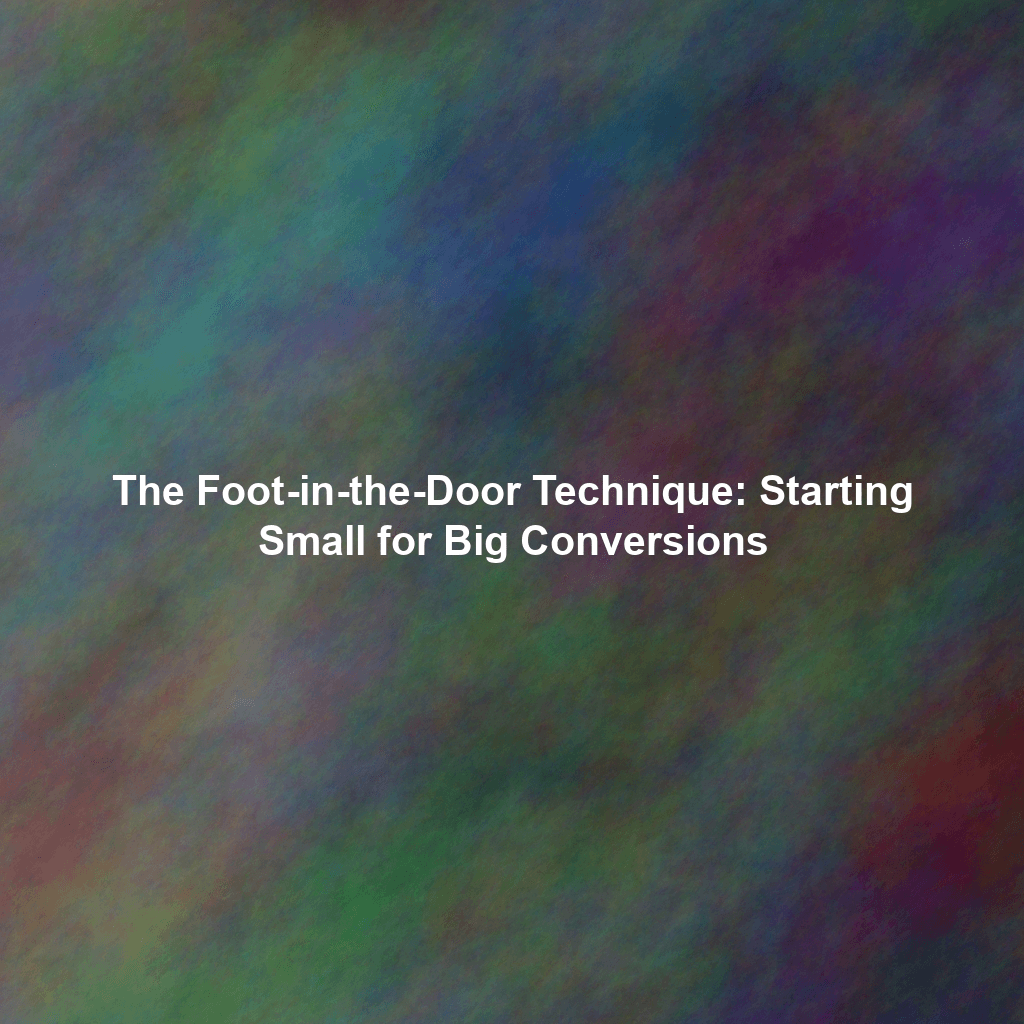Forget the hard sell. This approach is about building rapport, gaining trust, and gently guiding your potential customers towards a “yes” that ultimately benefits both of you. It’s like offering someone a sip of water on a hot day – refreshing and leading them to trust your judgment when you suggest a full bottle later.
What Exactly is the Foot-in-the-Door Technique?
At its core, the Foot-in-the-Door Technique (FITD) is a persuasion strategy based on the principle that agreeing to a small initial request increases the likelihood of agreeing to a larger, related request later on. It’s about starting small to achieve big.
Think of it like this: Imagine a salesperson knocking on your door and asking if you’d be willing to display a small “Drive Safely” sticker on your window. Most people would likely agree. A week later, the same salesperson returns and asks if you’d be willing to put a large, less attractive “Drive Safely” sign in your front yard. Surprisingly, people who agreed to the sticker are significantly more likely to agree to the sign as well. That’s the power of FITD.
The Psychology Behind the Magic
Why does this work? Several psychological factors are at play:
- Commitment and Consistency: Once someone agrees to a small request, they feel a sense of commitment. To maintain consistency, they’re more likely to agree to a larger request that aligns with their initial action.
- Self-Perception: Agreeing to the first request might change how people see themselves. They might start to view themselves as helpful, cooperative, or supportive of the cause, making them more inclined to continue acting in accordance with that self-image.
- Reduced Resistance: The initial small request lowers the psychological barrier to saying “yes.” It gets the ball rolling and makes subsequent requests seem less daunting.
Real-World Examples of the Foot-in-the-Door Technique in Marketing
Let’s explore some practical ways you can implement the Foot-in-the-Door Technique in your marketing strategy:
The Free Sample & Upsell
This is a classic example. Offer a free sample of your product or service. This small commitment (trying the sample) makes customers more receptive to purchasing the full-sized product or subscribing to a premium service. Think of beauty brands offering free samples or software companies providing a free trial period. Once they’ve experienced the value, upgrading becomes a much easier sell.
The Email Opt-in & Premium Content
Instead of directly asking visitors to sign up for a paid newsletter, start with a free e-book or a helpful checklist in exchange for their email address. This small commitment (giving their email) opens the door to nurturing them with valuable content and eventually converting them into paying subscribers.
The Social Media Engagement & Follow
Don’t immediately ask people to buy your product. Instead, ask them to follow you on social media or like a post. This seemingly insignificant action creates a connection and increases the likelihood of them engaging with your future content, ultimately leading to a purchase.
The Micro-Commitment & Major Purchase
For high-ticket items, break down the decision-making process. Offer a free consultation, a product demonstration, or a personalized quote. These small, low-pressure commitments build trust and pave the way for a larger purchase decision. Car dealerships are masters of this – offering test drives long before discussing financing.
Surveys and Feedback
Asking customers to fill out a short survey is a low-barrier request. Once they’ve invested a few minutes providing feedback, they’re more likely to consider offers related to the survey topic, such as a product upgrade or a personalized recommendation.
Ethical Considerations: Don’t Be a Sleazeball
While the Foot-in-the-Door Technique is incredibly effective, it’s crucial to use it ethically. Avoid manipulative tactics that trick or deceive customers. Transparency and genuine value are key. Make sure the initial request is something that truly benefits the customer and is relevant to the larger commitment you’re seeking. Don’t use misleading language or hidden agendas. Focus on building long-term relationships based on trust and mutual benefit.
Measuring the Success of Your FITD Campaigns
How do you know if your Foot-in-the-Door strategy is working? Track the following metrics:
- Conversion Rates: Compare conversion rates for customers who engaged with the initial small request versus those who didn’t.
- Engagement Rates: Monitor engagement with your content, social media posts, and email campaigns.
- Customer Lifetime Value: Analyze the long-term value of customers acquired through the FITD technique.
A/B testing different initial requests can help you optimize your strategy and identify the most effective approach for your target audience.
Conclusion: Start Small, Grow Big
The Foot-in-the-Door Technique is a powerful psychological tool that can significantly boost your marketing efforts. By starting small and building trust, you can gently guide your potential customers towards larger commitments and unlock exponential growth. Remember to prioritize ethical practices and focus on providing genuine value to your audience. When implemented correctly, the Foot-in-the-Door Technique isn’t just a weird marketing trick; it’s a smart way to build lasting relationships and achieve sustainable success.
 Skip to content
Skip to content

